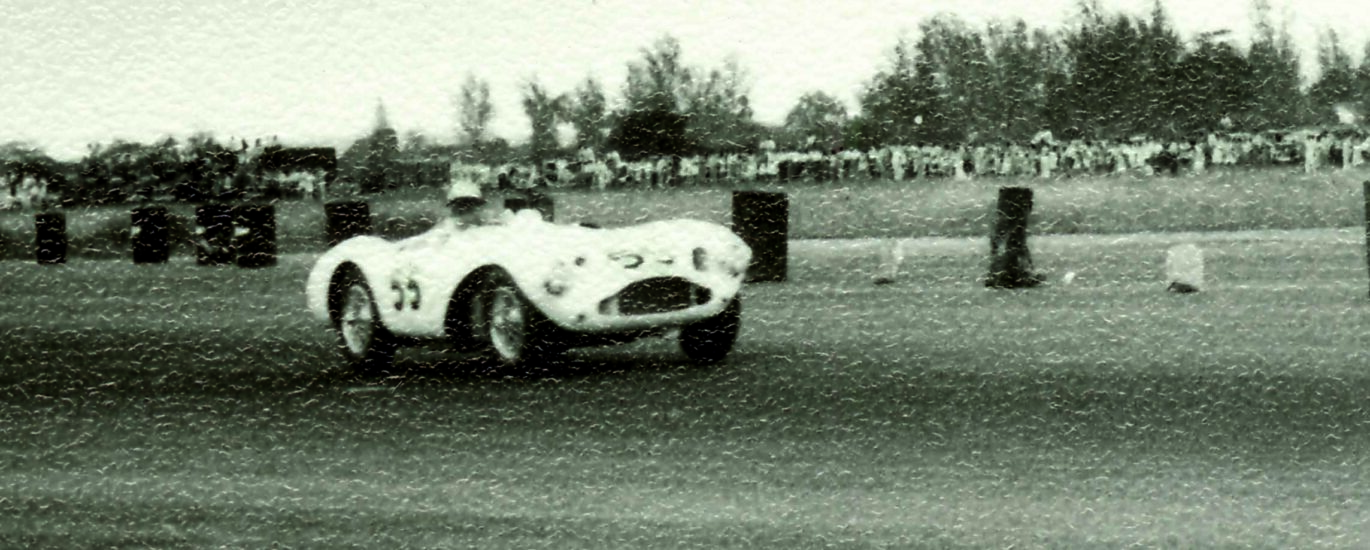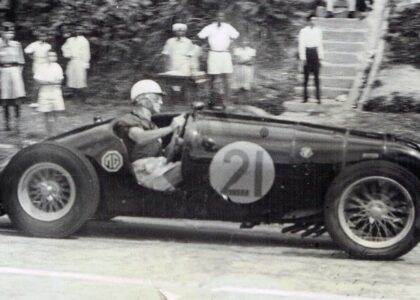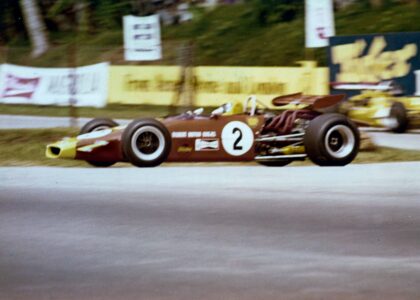By Eli Solomon
Last Updated 27 December 2023 (additional firsthand account on John Forde’s Austin Seven Special entry)
The only circuit race at RAF Station Changi
Singapore’s Changi Airport may be one of the most modern airports in the world today but back in 1957 it was just another RAF airfield populated by squadrons of Shackeltons and Sunderlands, until someone suggested using the airfield for a circuit race.
It was really a simple approach, brilliant even. Emulate the Silverstone Grand Prix. All airfields are flat; therefore, look for an airfield, preferably an RAF base, in the outposts of the Empire. The reason why Silverstone, a WWII airfield, was chosen as the venue for the 1948 British Grand Prix was that it was a disused airfield in Northamptonshire, closest to the geographical centre of England. About 120,000 people turned up to watch the inaugural race, mainly by coach and train.
Circuit racing at the air bases was a post-war phenomenon in Asia. The RAF’s Swettenham Aerodrome at Port Klang, Selangor, did come close to holding the first-ever Malayan Grand Prix in 1939, but was foiled at the last minute by the outbreak of war in Europe, albeit it the “Phoney War” [Genesis & The Winds Of War]. The construction of landing strips in the Second World War to boost air support was a necessity and by the 1950s there was a surfeit of flat tarmac ideal for the occasional race. And so, as with Silverstone in the UK and Sebring in Florida, Singapore’s motoring events on airfields took off after the war. The first instance of such an event was the 1949 Air Day mass-start Sprint, hosted by the Singapore Motor Club, along the perimeter track and up the runway of the island’s civilian Kallang Airport on 21 August 1949.

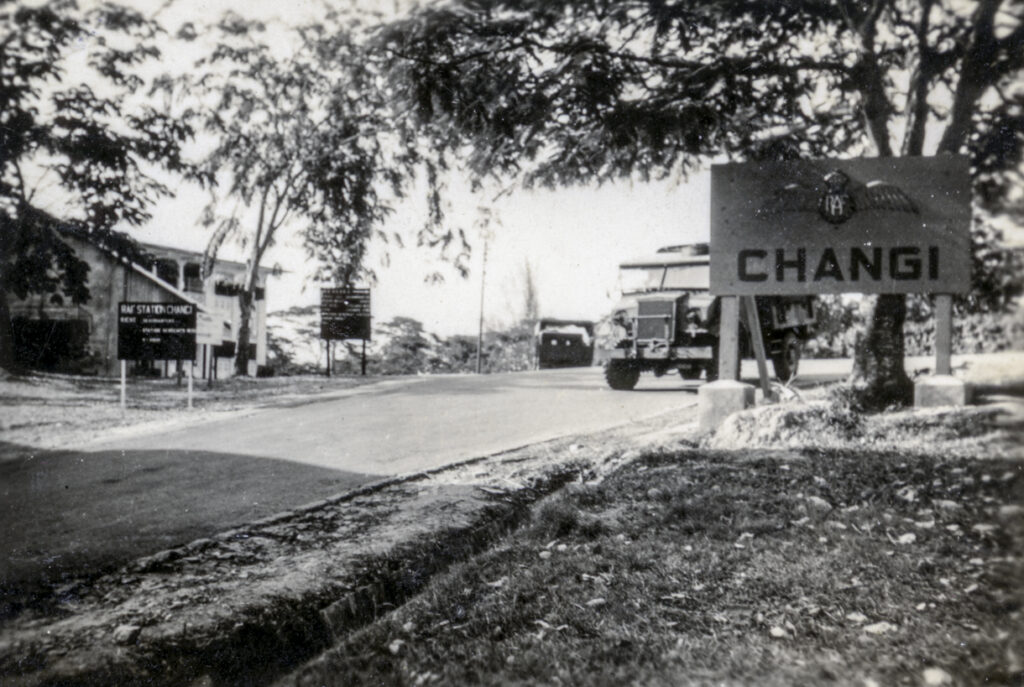
Welcome to RAF Station Changi.
AIRFIELD CIRCUITS
AIRFIELD CIRCUITS: There were four RAF airbases in Singapore: RAF Station Changi was the Far East Air Force (F.E.A.F.) headquarters that included the RAF’s hospital on the island; RAF Tengah was the jet fighter and bomber station; RAF Seletar, with six flying squadrons based there along with one Surface-to-Air missile squadron of Bloodhounds, was the largest unit on the island as the maintenance outfit for the RAF; and RAF Sembawang, the fleet amphibious forces’ base.
An attempt to hold a massed-start circuit race at the Sembawang R.A.S.C. Nursery Circuit in 1956 had failed. Major Mike Tice, who was instrumental in the formation of the Singapore Branch of the Forces Motor Club (FMC) in August 1956, then came up with the splendid idea of seeking the support of Air Commodore Geoffrey Nicholas Ernest Tindal-Carill-Worsley (known simply as TCW), CBE, President of the FMC (headquartered in the UK), to initiate plans for Singapore’s first proper circuit race.
TCW was an enthusiast as well, having had his RAF apprentices at RAF Halton in the UK construct the Halton Buckler and the Halton Tojeiro Specials. Also involved was pre-war Le Mans participant, multi-time Monte Carlo Rally entrant, 50-year-old Colonel Lord de Clifford, Edward Southwell Russell, 26th Baron de Clifford, OBE, TD. The Colonel was then stationed in Singapore.
After air reconnaissance was undertaken, the airfield, access roads and facilities were deemed to be suitable for such an event. Ultimate approval came from the Air Ministry and Air Marshal Sir Francis Fressanges, KBE, CB, the Commander-in-Chief of the Far East Air Force. It was the sweet spot of airfield racing in 1957 in the Federation of Malaya and Singapore because by 1967, it was clear that the critical mass of support for the sport afforded by the British and Commonwealth presence in Singapore and Malaysia would not last much longer, with full troop withdrawal by 1971. Plus by 1957, the communist threat had somewhat come under control.
RAF Changi had only recently received a Squadron of Avro Shackletons and was due to phase out the Sunderland seaplanes. All the RAF bases in Singapore and Malaysia were then hotbeds of activity for reconnaissance flights over communist-infested areas in Malaya so the Changi event was really a huge bonus for motor sports fans in the Far East. Major Tice had written to John Morgan, then Secretary of the Brooklands Automobile Racing Club (BARC), explaining the race he had in mind and Morgan had sent back the competition rules and regulations, including ‘Do’s and Don’t’s for Dices’.
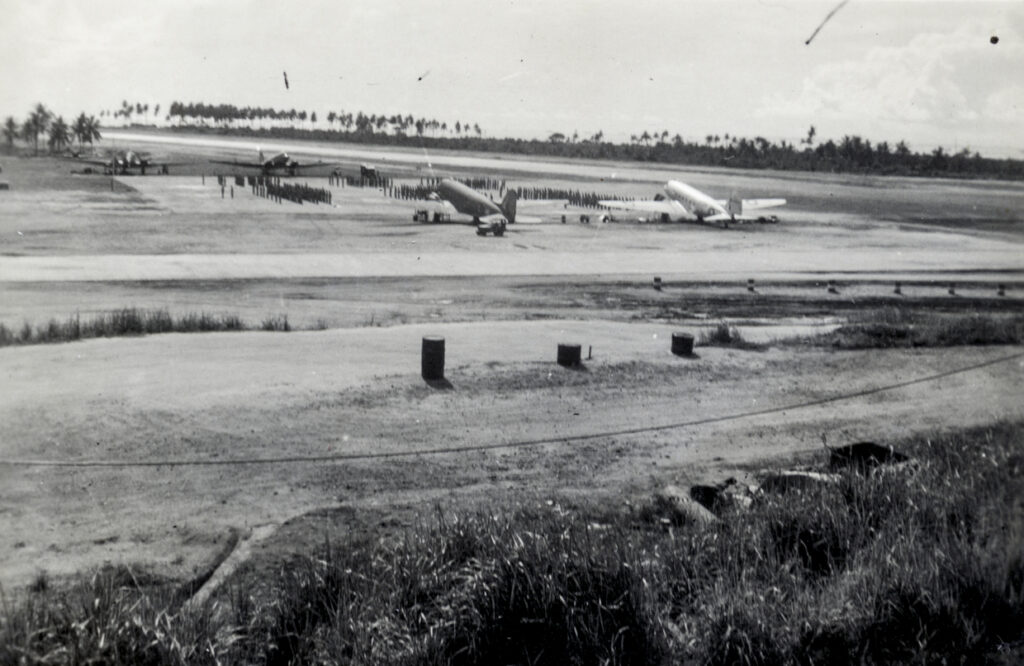
So RAF Changi’s perimeter road was fenced up in June 1957, water was piped in, scaffolding put up for a small grandstand to accommodate just 300 persons, and it became the venue for a race circuit for just one weekend. In fact, grandstand at the start-finish line aside, there was no other provision for seating whatsoever. It was a club event for members and not a Grand Prix, so spectator conveniences were not high on the agenda.
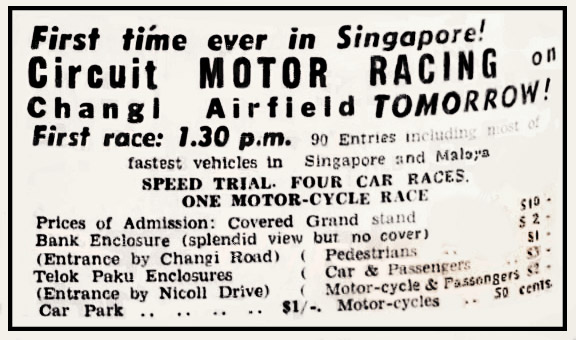
VIRUS-57
VIRUS-57: There was one very serious risk that motoring historians may not have appreciated. The spanner in the works was not irritating communist bandits behind every leaf but an influenza virus (H2N2) that had taken on global proportions by May 1957, forcing Singapore’s 670 schools to close with “about 45,000 pupils…down with influenza.” Passengers flying in were subject to being quarantined. The rumours of the cause were as far-fetched then as they would be today – from a radioactive fall-out from British and Russian H-bomb testing, to US Navy ships carrying the virus to Japan, to an outbreak originating in Communist China.
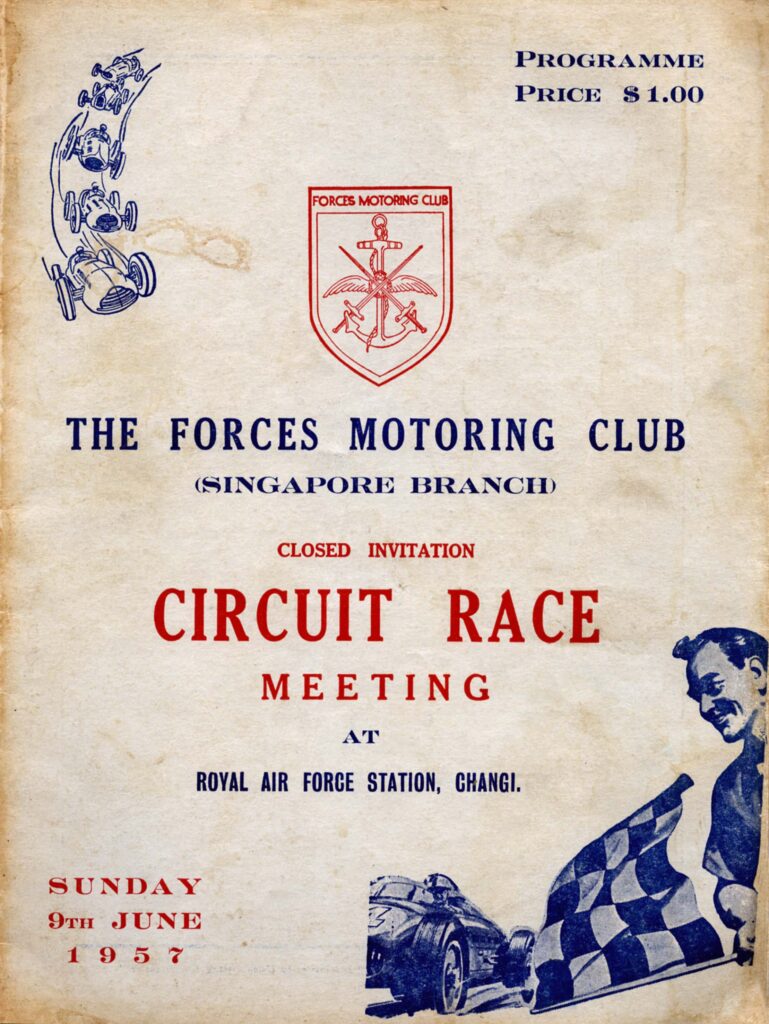
By the time racers drove into the RAF base on 8th June 1957, the “Asian Influenza Epidemic” had become a nationwide scare in the US! By mid-June, the World Health Organisation had labelled it the “Singapore flu”, ostensibly due to the first cultures being identified in the labs of the University of Malaya. In Singapore, top racer Jimmy Milne’s family was down with a bad case of influenza. His 15-year-old daughter Merlyn vividly remembers that she, her mom and their Amah were all sick. Her father, she recalled, “was trying to take care of us and what did he know about the kitchen and cooking???” That may help explain his sub-par performance in Neil Moncrieff’s Cooper JAP MkV in the event [the Moncrieffs were on leave in England for six months from 27 April 1957]. In the words of a University of Malaya Virologist, who himself was related to one of the race entrants, this “was Singapore’s first ‘big’ one.” Indeed it was. And it would not be the last. Regardless, the key men behind the weekend were determined the show would go on, viral outbreak or commie jungle spotting or not.
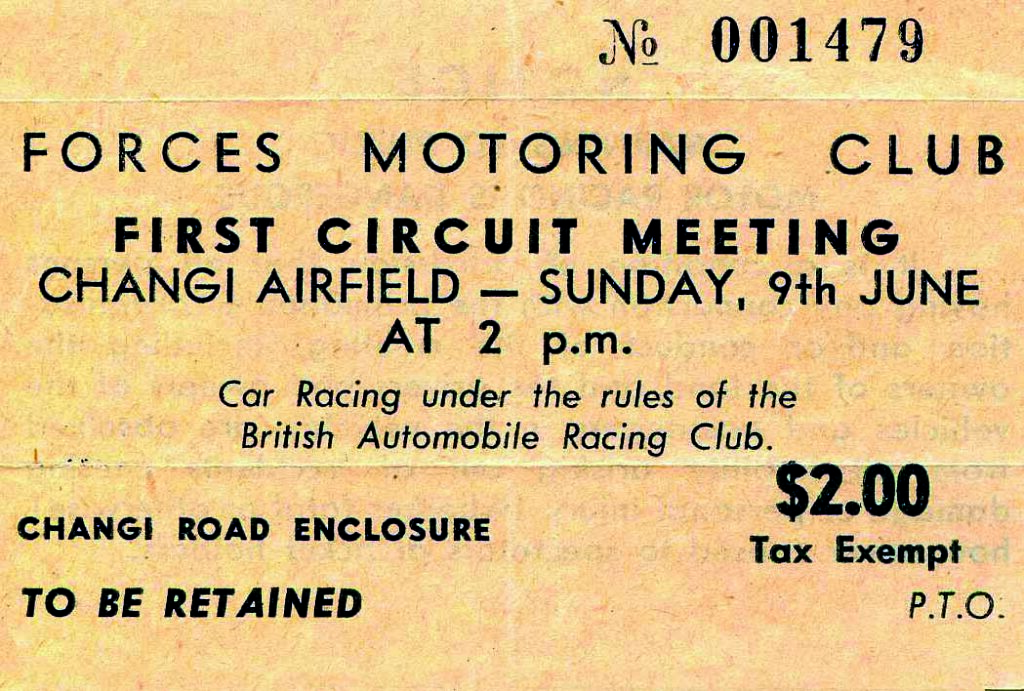
THE SHOW MUST GO ON
THE SHOW MUST GO ON: At the instructions of Air Commodore TCW, RAF Changi’s Jim Hodson planned the 1.78-mile course and drew the layout that encompassed part of the airstrip and the perimeter track. The circuit was 3,130 yards (1.78miles/2.86km) long with a three-quarter mile straight. The corners were given appropriate corner and straights derived from the English circuits of the day such as Lavant, Maggots, Woodcote and St. Mary’s, with Hairpin Bend and Changi Corner thrown in so it didn’t look like a Goodwood or Silverstone copy. Though a Forces Motoring Club event, it also had the support of the Singapore Motor Club (SMC) and the date was set for the second weekend in June.
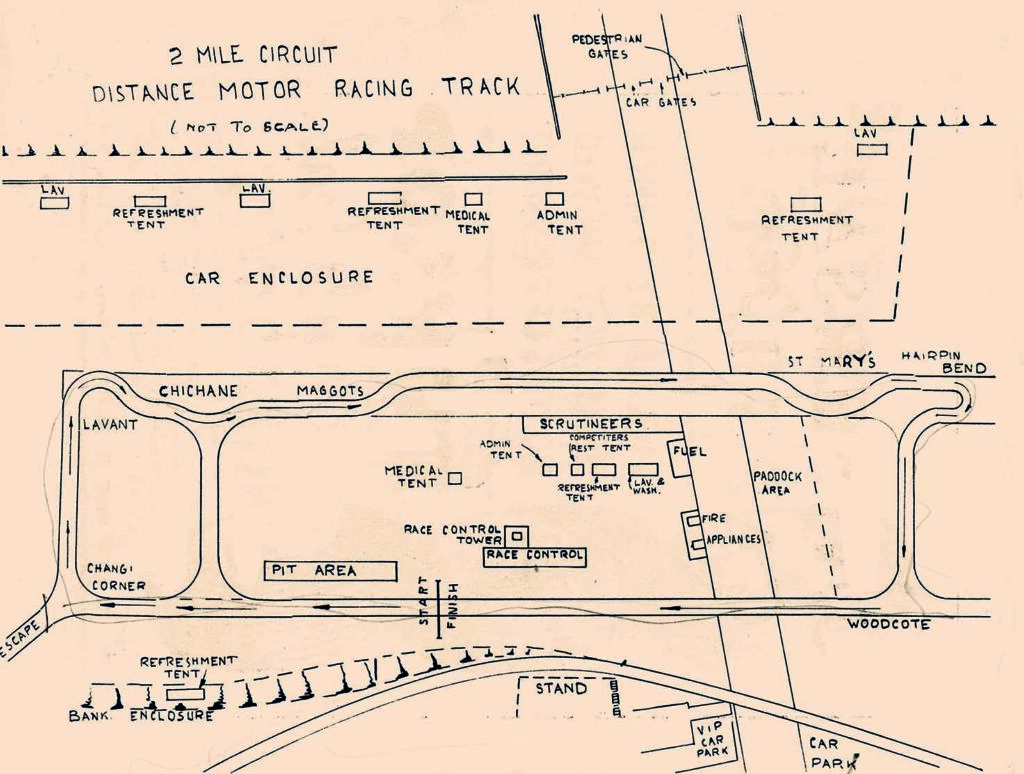
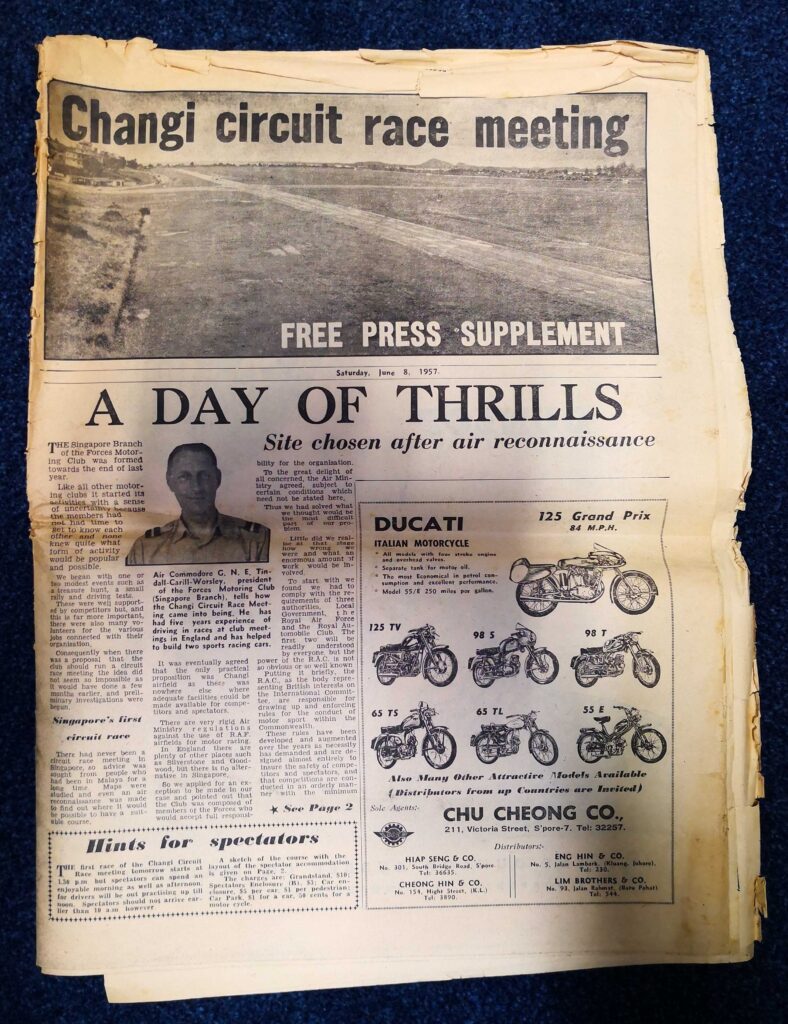
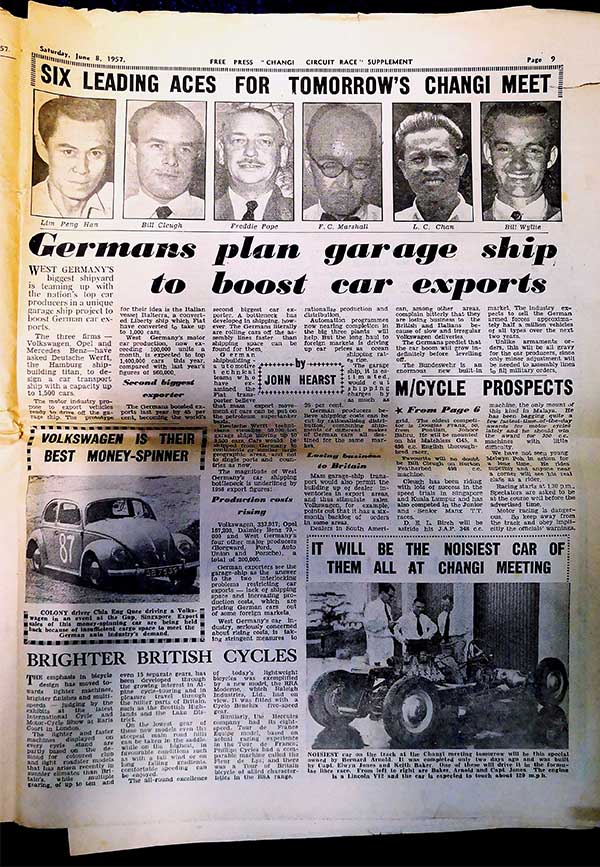
Paul J. Gibbs Pancheri, motoring enthusiast, Singapore and Malayan Motor Club pioneer and Bentley Boy, recalled, “Whilst still in the village [as a PoW in Changi], I was fortunately involved in hauling trailers of rice sacks into the POW area…I dreamed of creating a racing circuit using some of these excellent roads, but never guessed that after the Japanese had built an airfield (with our labour) in this area, I would in 1957 drive my Bentley in races on the roads that had been built as Changi Airfield.”
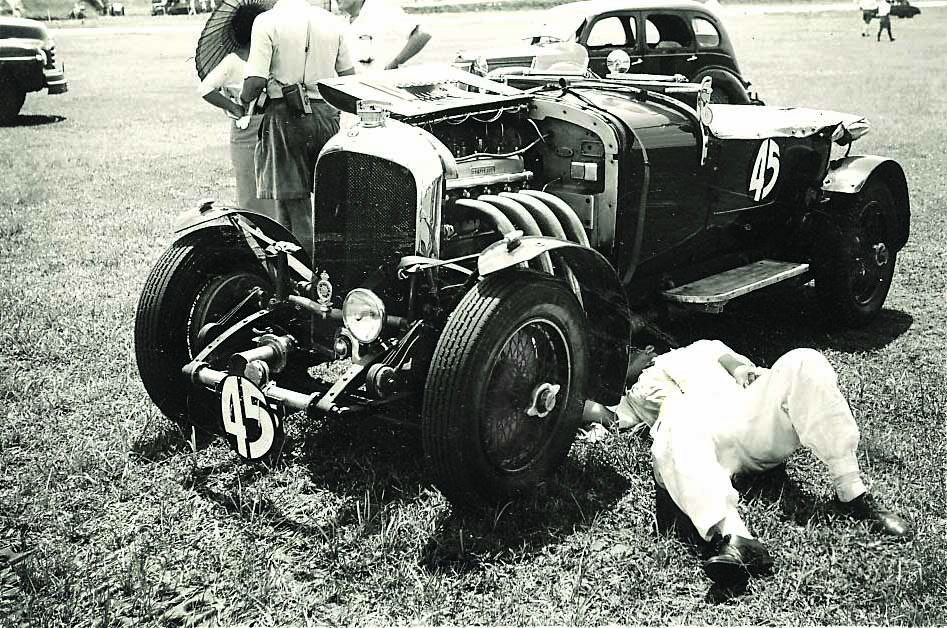
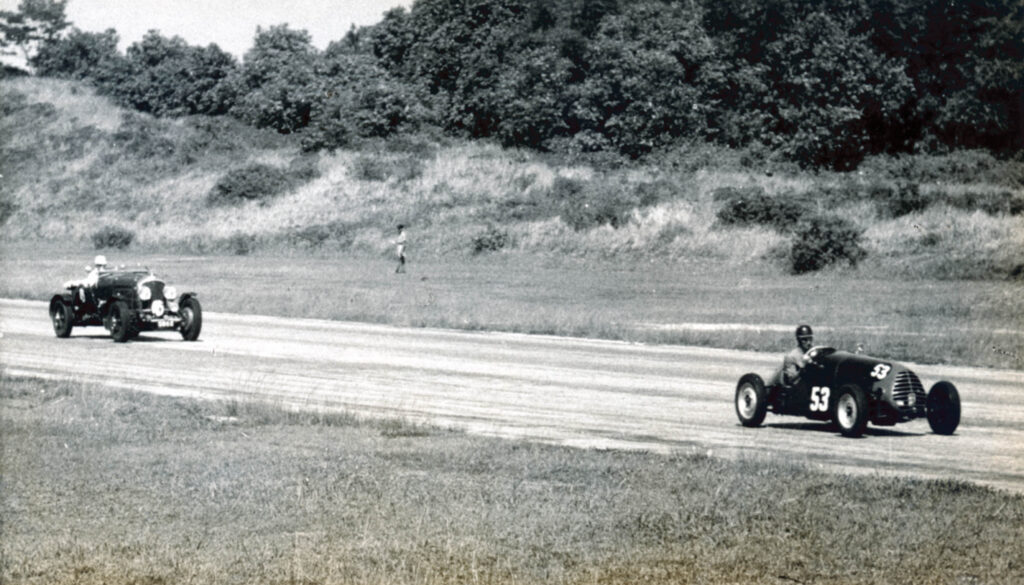
Paul Gibbs Pancheri’s Bentley behind the Fiat Special of J. Swinburne (driven by J.A. Broadman).
The event marshals were generally members of RAF Tengah, Seletar and Changi. Chief Marshal was Flt. Sgt Eric William Metcalf of 14 Squadron Royal New Zealand Air Force stationed at RAF Tengah. The base was equipped with 16 de Havilland single-engined Venom jets operating against communist insurgents. Though the official program did not list the officials of the event, this author was able to obtain the official list of “Final Instructions” issued to entrants that included names of the officials.
The Royal Automobile Club’s Steward was Shell’s Allen Crabbe, President of the Singapore Motor Club back in 1955; the Forces Motor Club’s Steward was Air Commodore TCW; and the 1957 SMC President and Race Steward was John Gwatkin-Williams, who had officiated at SMC events from 1949. Clerk of Course and Secretary of the Meeting was Major Mike A. Tice who, in 1956, had been at G II Intelligence Singapore District before ending up living in the 2nd Gurkha Regiment quarters without a military position, through no fault of his. Tice, arguably, was the man behind the success of this event.
Ken Wilson, Wireless Mechanic from the 60 Squadron RAF Tengah, another volunteer for the event, remembered being given some flags, a red badge, and instructions to marshal during the races. Some of the photos in this story are his. Senior Aircraftman Les Davies, who was doing his National Service as a Teleprinter Operator at RAF Changi between April 1956 and November 1957, had no particular interest in motor sports but nonetheless filmed the event with his cine camera using a 25-foot-reel of 8mm Cine-Kodak Super-X film.
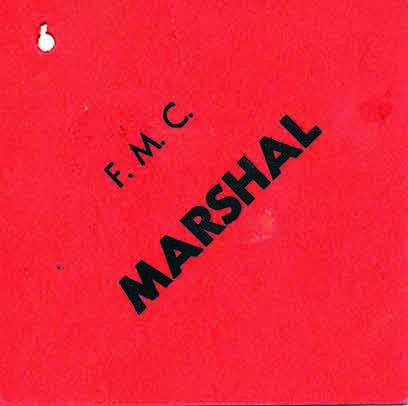
Scrutineering took place on Saturday afternoon from 2pm. “Tiger Time” was scheduled from 3.50pm to 4.15pm at Lyons Motors on Oldham Lane, off Orchard Road. Scrutineering was under the three pairs of watchful eyes of Captain John Mills, second in command to Mike Tice in ‘A’ Company of the Singapore Guard Regiment; Major Peter Stocks of the Reserve Officers Training Corps; and Lance Froome, chosen by Tice. If all went well, competitors were permitted out on the circuit for practice on Sunday from 8.15am till noon, sequenced by allocated race number. The cars were parked in the infield paddock situated between Maggots and St. Mary’s. There must have been a lot of interest, whether local or not is not clear but the embankment was overrun with spectators and the police were compelled to keep them back.
A couple of competitors came up with a rather interesting way of keeping their cars safe from the weather. Keith R. Baker, then working for trading company Guthrie’s building material department, set up a 30-foot-long and 19-foot-wide rainproof inflatable hut for Bernard Arnold’s Lincoln V12 Special, Warrior Bristol, and a third car. It was good marketing strategy.

AT THE RACES
AT THE RACES: The curtain-opener for the Changi Circuit Race Meeting was a Le Mans-style 30-minute “high-speed” Team Sprint. There were 22 cars entered with MG T Types, Triumph TR2s and 3s and Jaguar XK120s well represented. The cars were lined up for a Le Mans-style start and there was a compulsory pit stop. Teams had various options – either a wheel had to be changed (or removed, laid down and reinstalled) or four plugs had to be changed (or laid down and reinstalled, if new ones were not required).
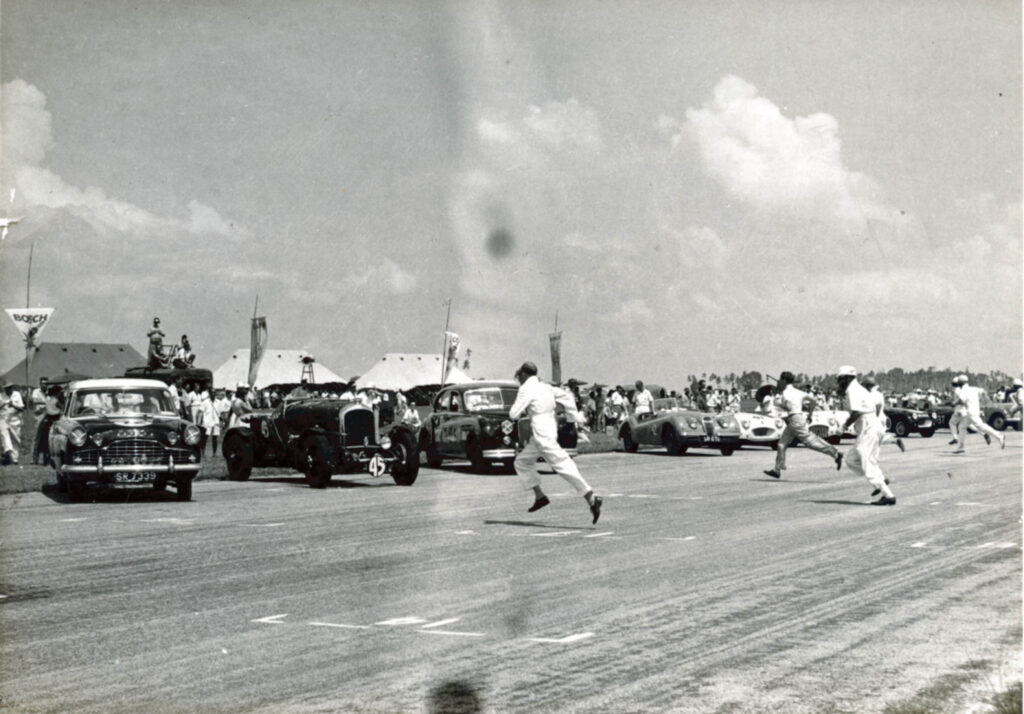
Start of the 30 minute High Speed Trail. Not too many finishers for this event. The Ford Zephyr (2260cc #35 J.A.R. Hodson) nor the #44 Mk7 Jaguar of L. Lee finished. Other cars featured include the 4 1/2 litre Bentley of Paul Gibbs Pancheri (#45) sandwiched by the Zephyr and the Mk7 Jaguar. Next to the Mk7 Jag: #42 Jaguar XK120 (660055) reg SR67A, (entered by Capt J.A. (Jim) Atkinson and raced by U.L.F. Von Maydell); #41 TR3 (?) next to the XK120 – Jan Bussell; Bill Wyllie in the #40 TR3; J. Clifford #39 (TR3), Tony Huggett #38 (TR2) and W.H. Johnson #37 (TR3).
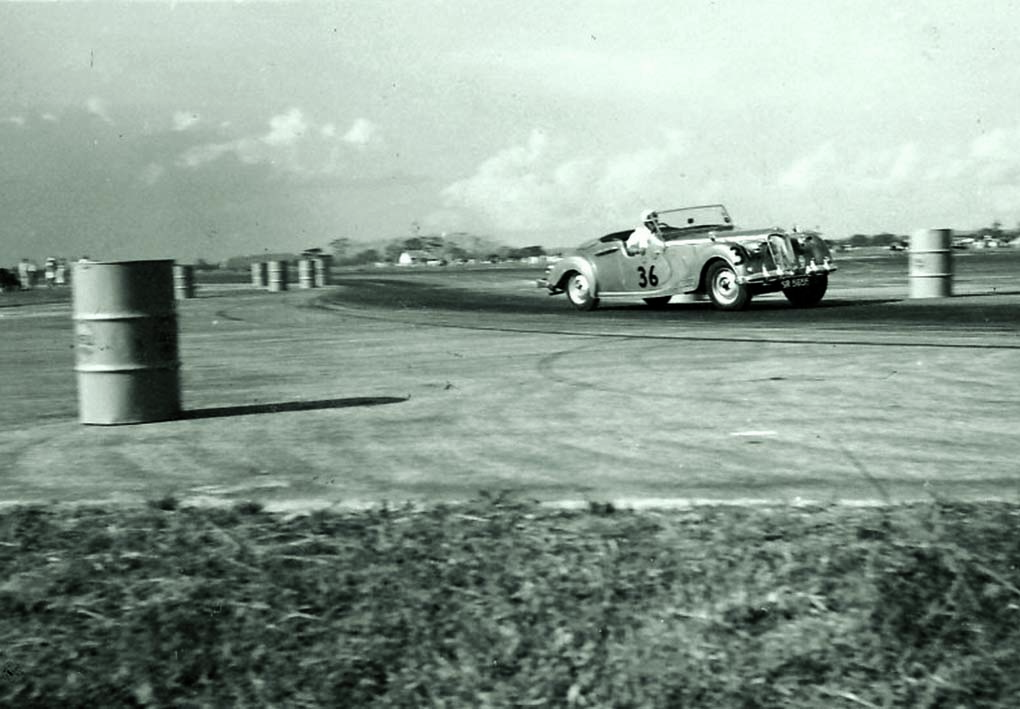
The Standard-Triumph team comprising 24-year-old Wearne Brothers’ W.R.A. ‘Bill’ Wyllie (Triumph TR3); optician Anthony J. ‘Tony’ Huggett (Triumph TR2); and commercial pilot Francis Jan Bussell (Triumph TR3) were victorious in this event. Wyllie, an Australian, would go on to win the 1960 Johore Coronation Grand Prix [see On The Stroke Of Two] but his greatest achievements lay years ahead, in Hong Kong’s corporate world. Wyllie finished a lap ahead of both his teammates in a car that he had already toured Europe and Australia in before shipping it in early 1957 to Singapore where it was road registered (SF4096).
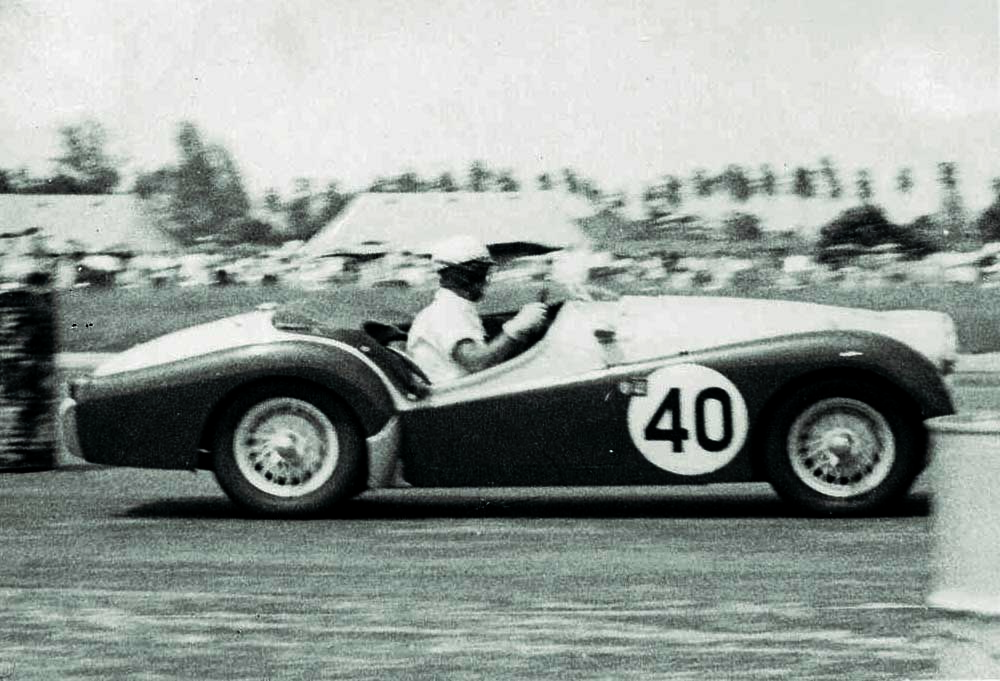
The main event on the programme was a race for Formula Libre racing and sports cars run over 10 laps, making it more of a sprint than a full-blown Grand Prix. Entries were open to members of the FMC and the SMC. Considering the lack of any circuit racing in Singapore, there was still a plethora of sports and racing cars that entered, the same cars that were used for the sprints and hill climbs, and a number that had raced between 1949 and 1953 at the Johore Grand Prix. Naturally, there were new arrivals: Thoroughbred sports racing cars such as the Aston Martin DB3S and Warrior Bristol invoked images of projectiles capable of indecent speed. Cars that were capable of cutting through the hot (or wet) and salty tropical Changi air at over 130mph included a plantation-based 4.5-litre V12 Lincoln Zephyr Special, the aforementioned 2.9-litre Aston Martin DB3S, and a rare 2-litre Bristol BS4 Mk2-powered Cooper, referred to earlier as the Warrior Bristol.
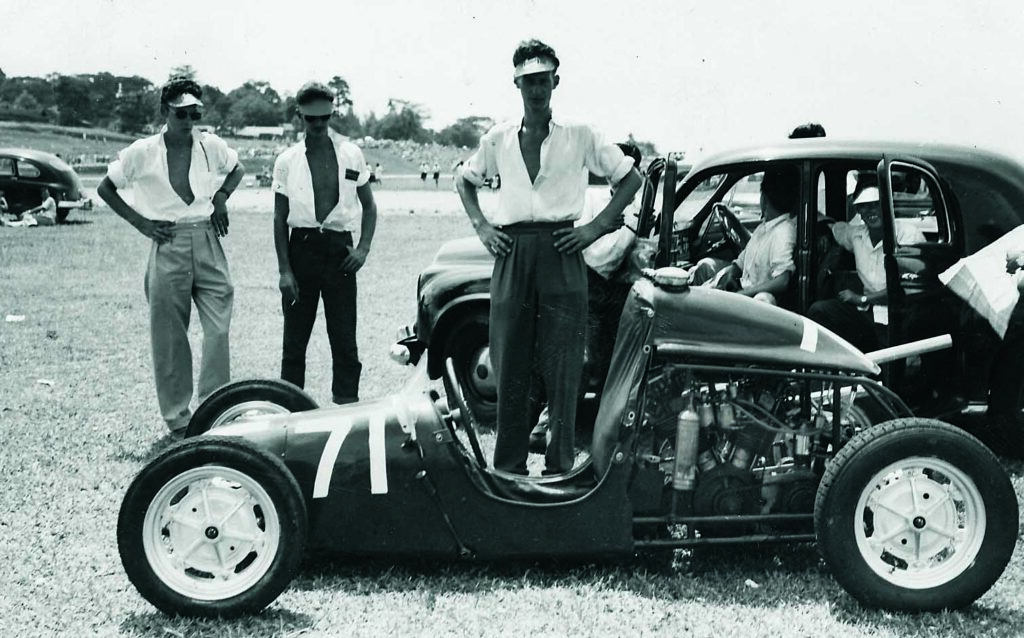
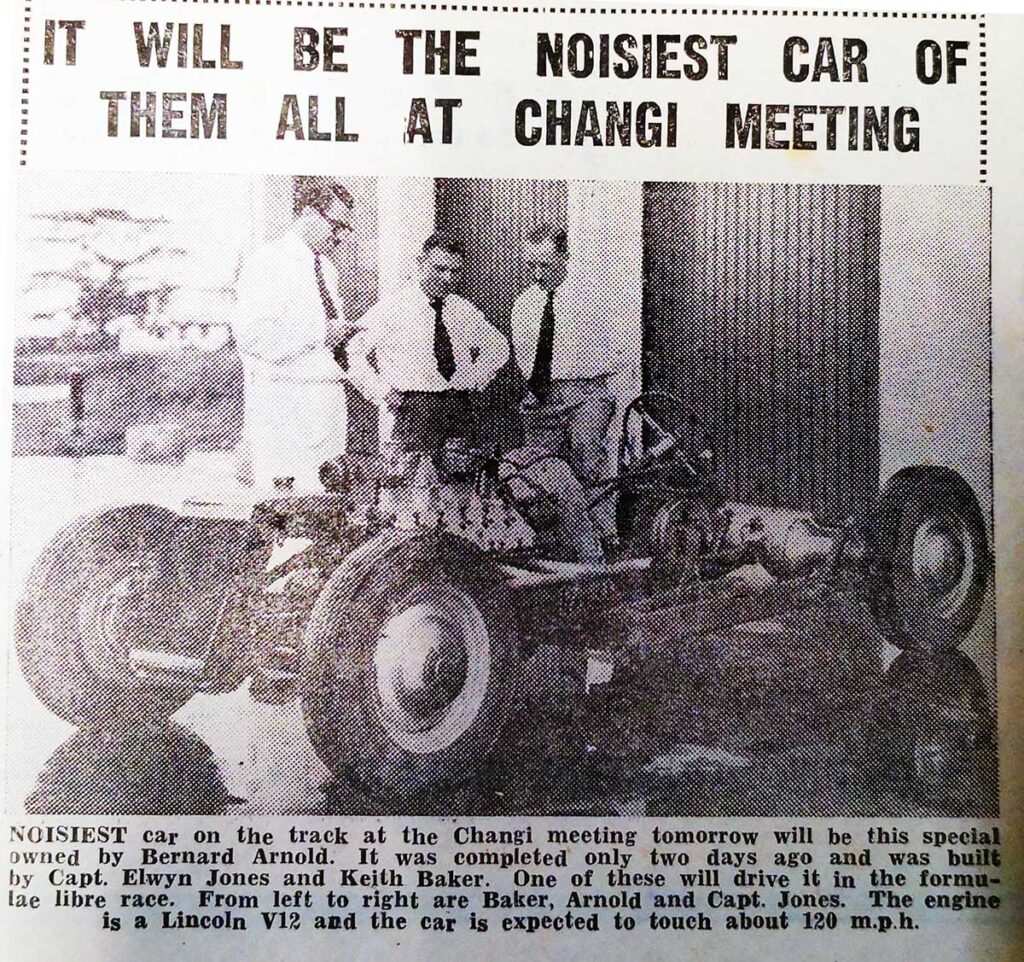
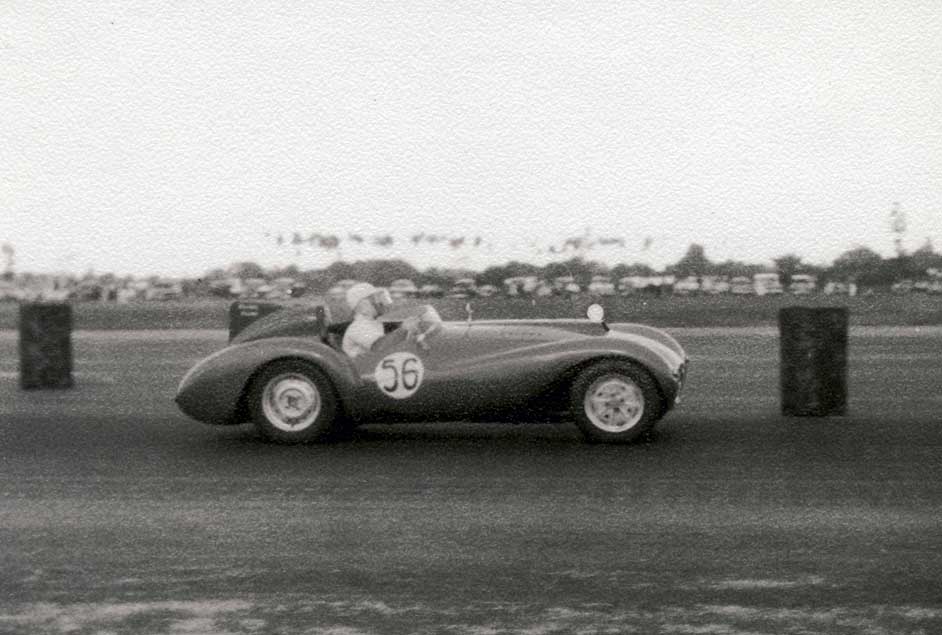
Top racer and builder Lim Peng Han’s Lim Special (a Kieft Mk1A in an earlier life) was entered. Even without supercharging, the JAP two-stroke engine could hardly have been expected to endure 29km on full throttle. Jimmy Milne, another very experienced competitor, had use of Neil Moncrieff’s Cooper JAP MkV, and was expected to do very well as the car (and its two regular drivers) had been extremely successful at club events. The timing for Moncrieff was most unfortunate as he and his family were off to England on six months leave from 27 April 1957 and would miss this major race.
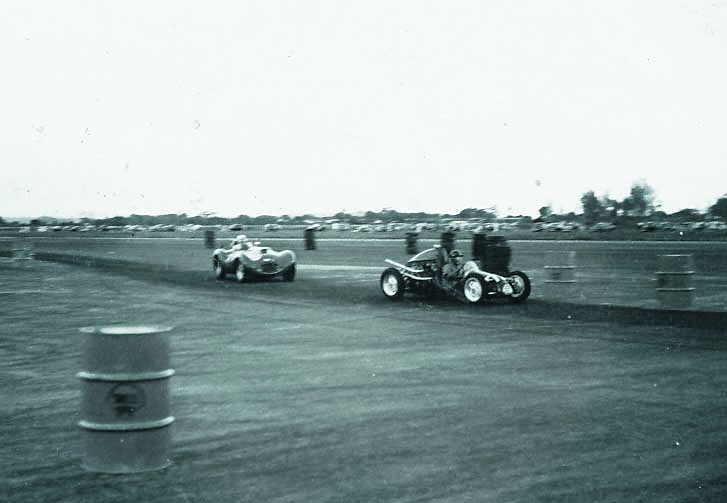
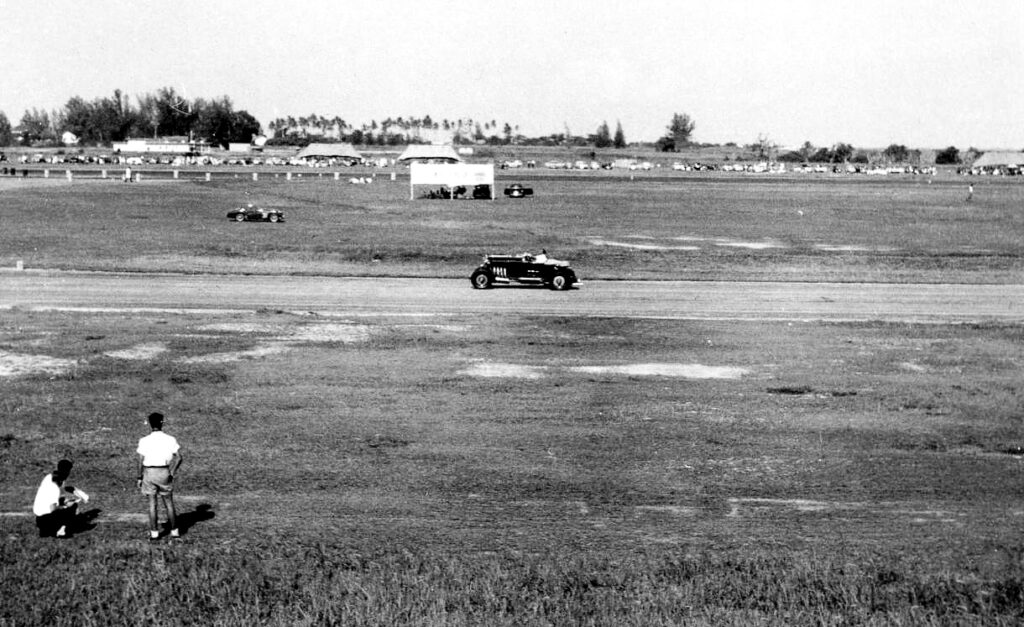
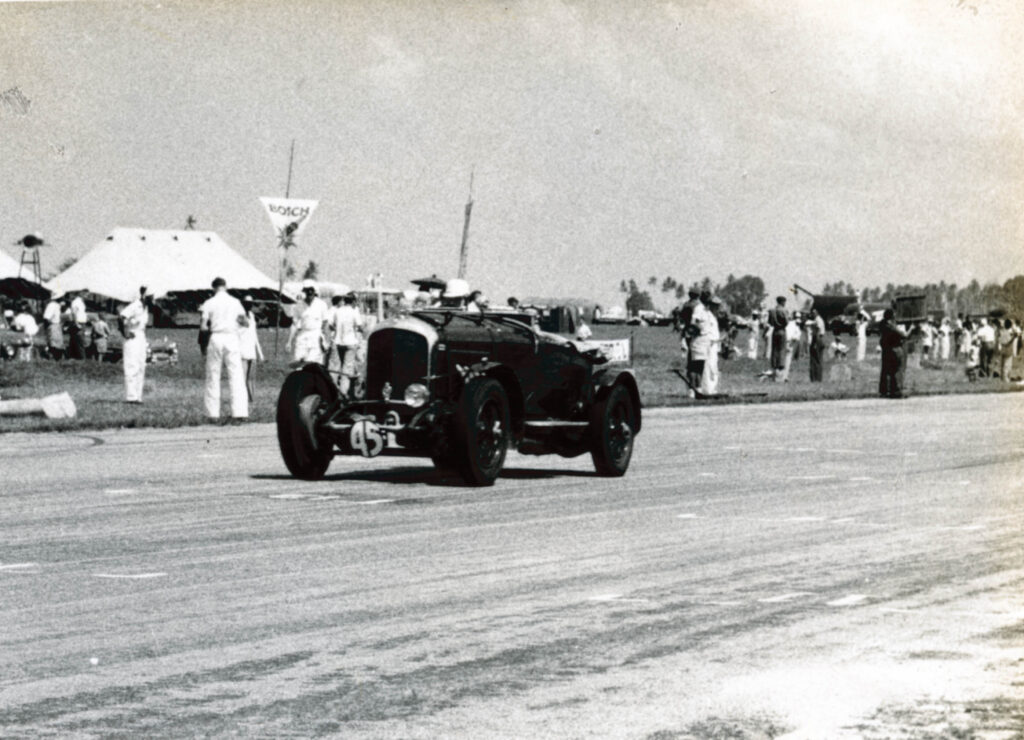
Pancheri’s 4 1/2 litre Bentley would have been the oldest car at Changi that weekend.
Contraptions that ran on a cocktail of methanol, acetone and benzene were not excluded. That was at the top end of the spectrum. The curve ball was, of course, the balloting that determined starting positions on the grid. Interestingly, practice did not count as qualification because the grids for the Formula Libre race, and the sports car race, were determined by ballot. There was one interesting paragraph in the final printed instructions issued to entrants: Remember that you are a racing driver and not a perambulating chicane.
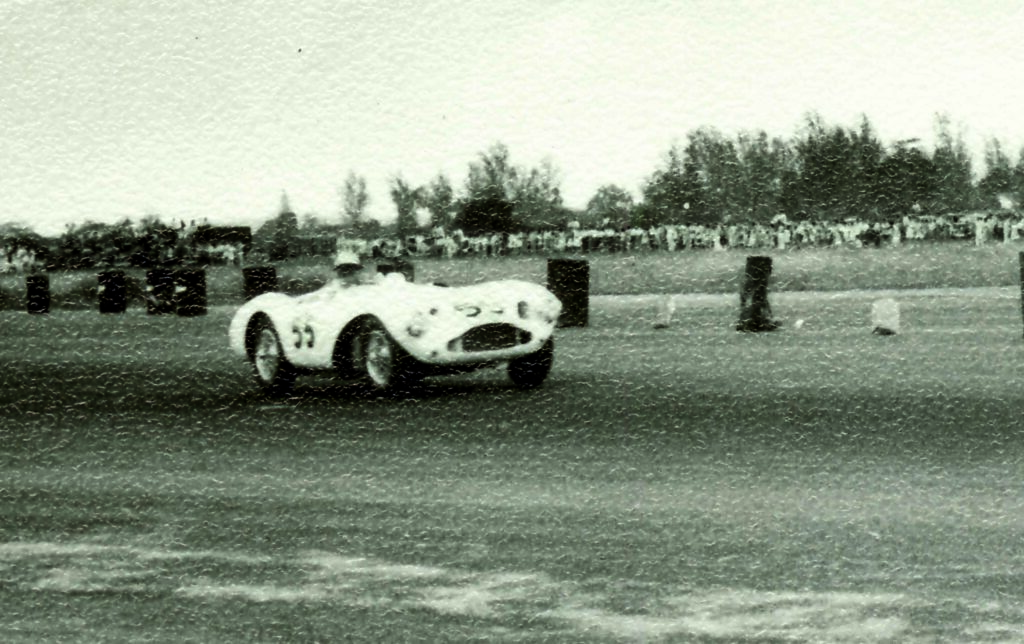
Chan Lye Choon, one Singapore’s top racers of the 1950s and early 1960s, had graduated from racing open-wheel MG T Types to Formula 3 Cooper JAPs. He and his brothers had inherited car and motorcycle agency Eastern Auto Company in 1949. The company held the local agency for Aston Martin, Citroën and several others so he was perhaps best equipped with a support crew and an entourage of helpers and hangers on. In 1955, his royal blue DB3S [see For The Price Of A House] had arrived with time to spare for the Macau Grand Prix that year.
Following a disappointing Macau race, the engine was returned to the factory for a rebuild. A few modifications had also been made to aid in cooling. The dark blue car was then repainted in Old English White. The white DB3S was one of the favourites for the Formula Libre race that weekend, along with Bernard Arnold and his Cooper Bristol, and Jimmy Milne running Australian Neil Moncrieff’s Cooper JAP MkV. There was also Freddy Pope’s Jaguar XK140 with full bodywork on the car rather than the monoposto kit occasionally used from Brian Hawes’ XK120 Roadster from the early 1950s. It was not a small grid by any means, with 18 cars officially entered in the main event.
In the end, the Aston Martin made it look easy and Chan trotted home in the main race with a time of 19m 19.1s, averaging 90km/h. He also set FTD at 1m 49.5s, the longer start-finish stretch giving him the edge over the nimbler-handling Cooper JAP and Lim Special. Lim Peng Han, doyen of Singapore motor sports from the late 1930s until the 1960s, managed to coax his highly-strung Lim Special to second, 34.7 seconds behind; the eye-watering fumes from the JAP engine suggested it was on the brink of detonating when in actual fact second gear had perished and Lim had to make do with limited ratios.
Malacca-based Bernard Arnold [Bernard Sydney Arnold died in September 1963, aged 49, after a long illness. At the time of the Changi Circuit Race, he was an engineer of Tanah Merah Estate in Port Dickson], who undoubtedly wrung the neck of his Cooper Bristol (nee Warrior Bristol), was a further 14 seconds behind Lim, nursing his Bristol 2-litre motor, restricted by a much lower rev limit. Without the handiwork of Arnold and his friends Keith Baker and Capt. Elwyn Jones earlier in the day, the car may never have made the grid.
Lim Peng Han’s protégé, Champion Motor’s (VW and Land Rover agents in Singapore) Chia Eng Quee, was fourth in his home-built Rover-engined Eng Quee Special. Jimmy Milne had started off promisingly in Neil Moncrieff’s Cooper, third in the pack for the first few laps. He looked like a sure-podium finisher until his engine coughed enough and he dropped out at the three-quarter mark.
We do not know how Major Mike Tice’s #66 750cc Austin Special fared in the hands of his Kiwi air force friend John N. Forde who was based at RAF Tengah with the RNZAF, but we do have Rex Carkeek’s first hand account of the rush to get the little Austin ready, like when the first test yielded a car with multiple reverse ratios and one forward ratio. It appears that Rex was entered in the Austin,which sadly expired with a driveline failure in his event.
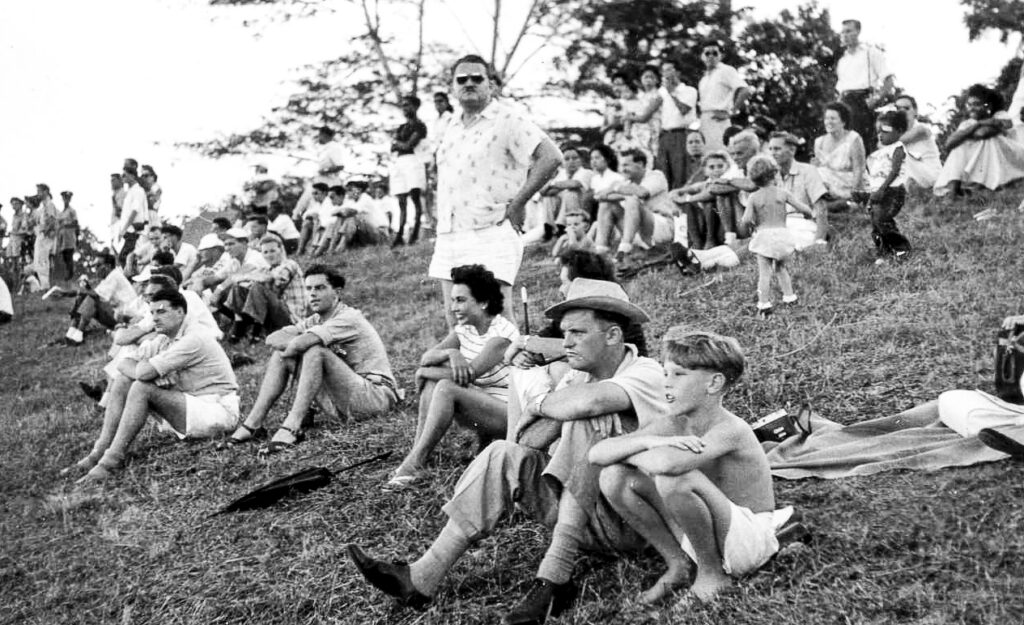
Spectators must have been thankful there was a six-event day of races on the island, even if it meant a rather long bus ride all the way East to Changi. Grandstand tickets were priced at $10 per head, the enclosure along the main straight at $2, and parking at $1 per vehicle (naturally, motorcycles had a discounted rate). The local media estimated 40,000 people would show up for the event though a more realistic figure would have been under less than 10,000.
In the motorcycles 10-lap race, it was a foregone conclusion that works manager of Hume Industries (Far East) William ‘Bill’ Cleugh would win in his 499cc Norton Featherbed, having raced in the Isle of Man Senior International in 1954 in his Norton. He did not! In fact, the winner Peter Evans came from the 350cc and under class, riding a 348cc BSA Gold Star, a totally unexpected result for the 22-year-old Flying Officer. 32-year-old Cleugh finished second overall, and first in the Unlimited Class in his Norton.
There was a fair diversity of entrants with many local enthusiasts participating. Well-known regulars such as Lemat bin Chumek, Peter Chan, 27-year-old workshop foreman Louis Chia, traffic constable J.K. Leembruggen, 29-year-old Soh Guan Bee, Mervyn K.P. Poh and 49-year-old Douglas Frank (Matchless G45) made up just a few of the locals out of the 21 entries. That was very good going because the locals were grossly outnumbered in the car races.
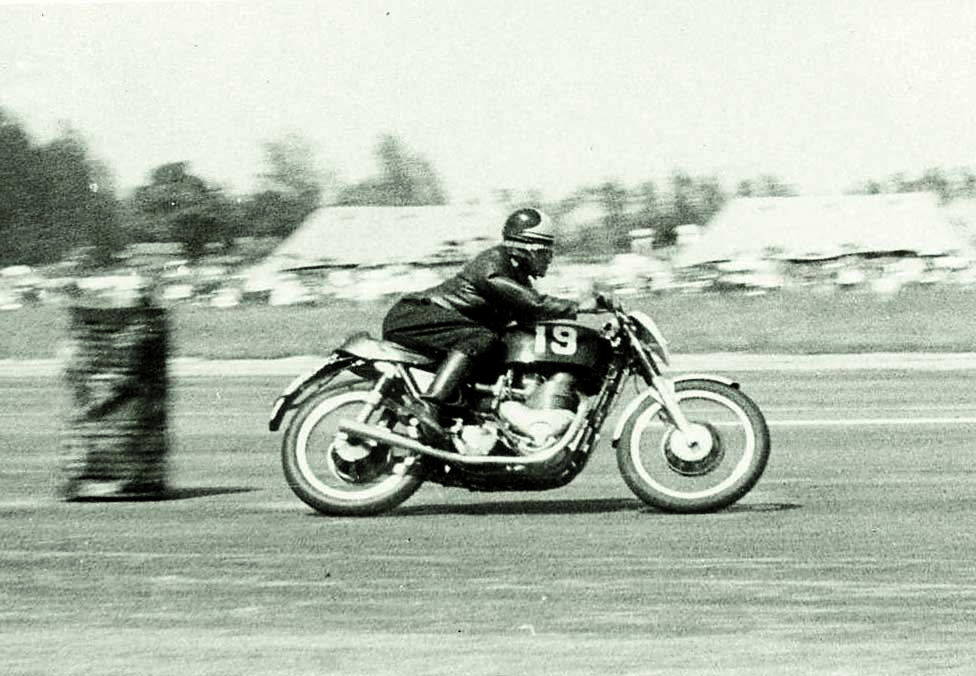
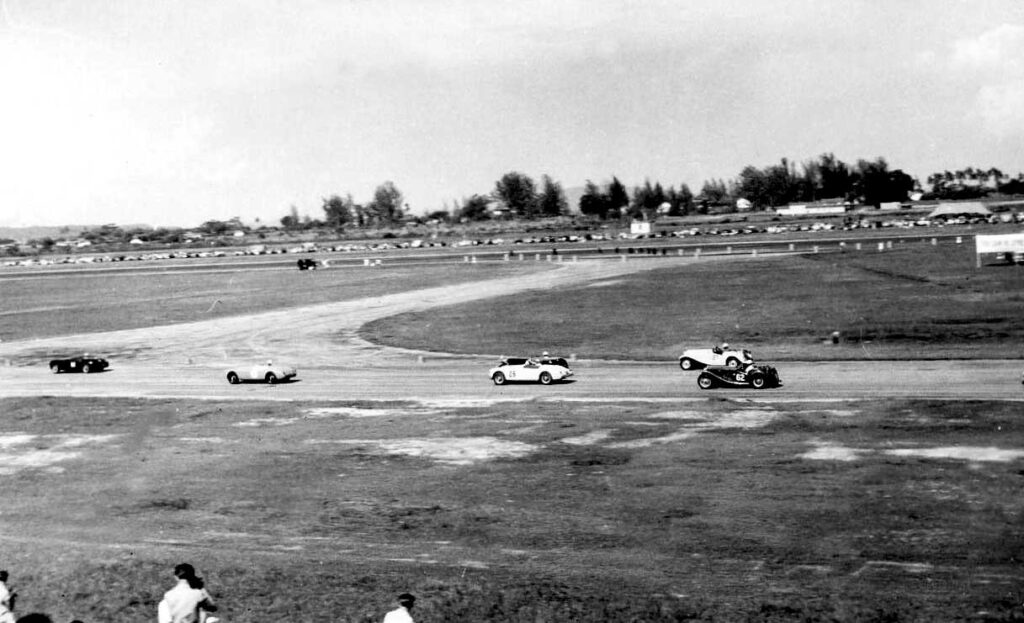
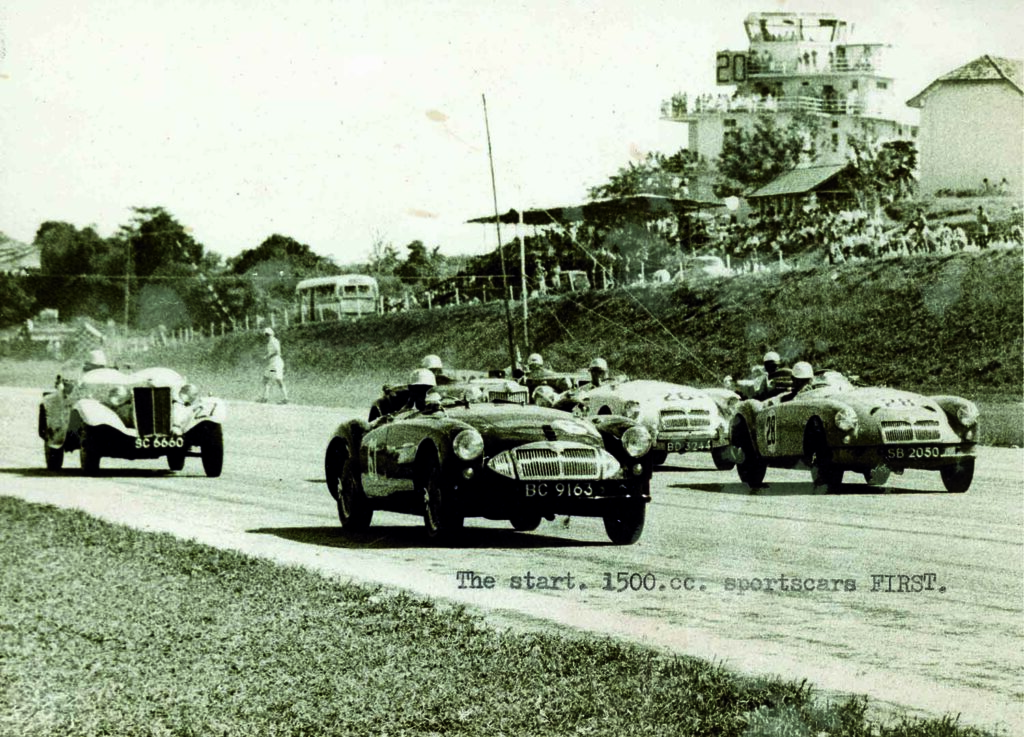
SPORTS CARS
SPORTS CARS: The 1500cc and Under Sports Cars were out at 3pm for their 5-lap “sprint” race. Of the twelve cars entered, ten were MGs! The newest cars were the MGAs, of which architects Stanley Leong; C.O. ‘Mick’ Jennings; and John McPhail, 41-year-old manager of the Amber Estate in Senai in Johore, had first series MGA 1500cc examples. Certainly, the MGAs had a huge advantage over the MG TCs, TDs and a pair of Fiat Specials driven by Chew Chek Leun and Francis Baruch; the latter’s Tiger Special was the former Keene and Knight KK Special owned by S.R. Knight and raced by Knight and Lim Peng Han some years earlier.
Much favoured Mick Jennings and his MGA, nicknamed the Black Panther, did not win. This accolade went to Leong in his “works prepared” MGA who finished in 11m 20s. Jennings came in second. His career in Malaya was coming to a close by then. He had already relocated his daughters to New Zealand and he and wife Ruth were themselves preparing for their big move there. There was another class battle that went on – for cars 1300cc and Under. D. Lynn won in his MG TC in a time of 11m 28s, followed by 34-year-old engineer at Hammer and Co. Derek James Brooker second in an MG TF [There is a conflicting account in the Straits Times of 10 June 1957 with second place in the 1300cc class going to Teo Kim Choon in an MG TD], and educator Francis Baruch third in his Tiger Special.
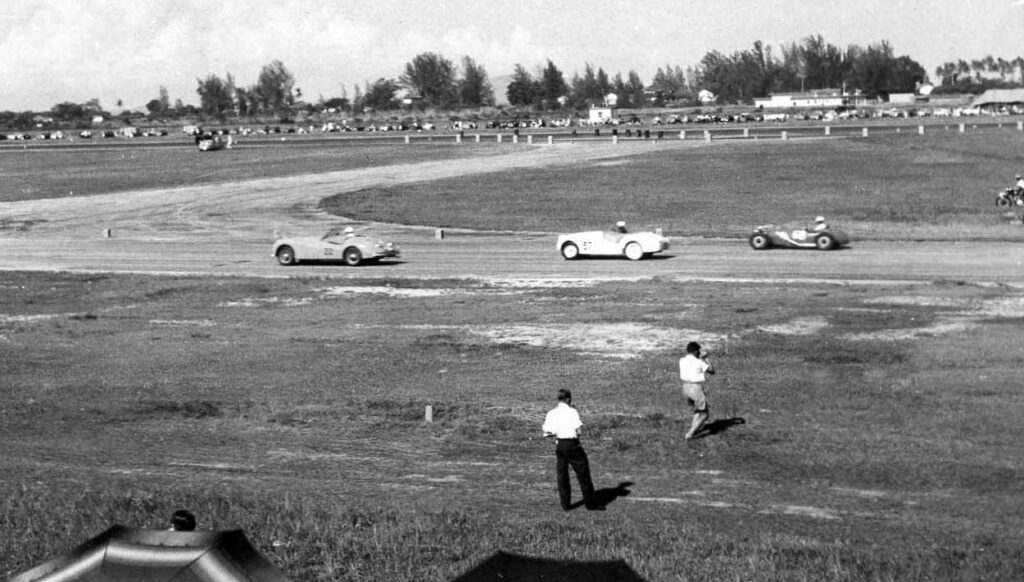
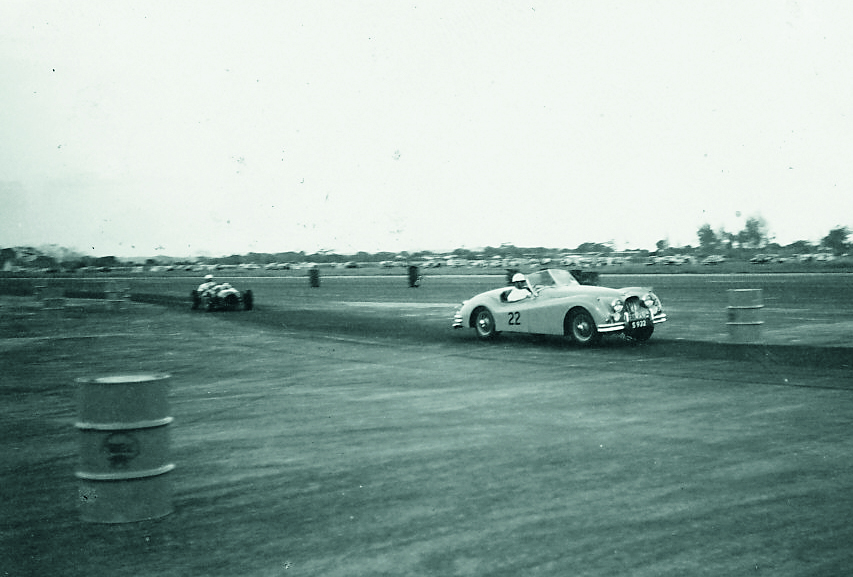
The 1501cc-2000cc, Up to 2500cc race and Unlimited cars went out at 3.30pm for their 5-lap sprint. Where the MGs had a stranglehold in the previous race, the six Triumph TR3s plus one TR2 accounted for seven of the grid of 15 cars. Pilot Jan Bussell beat army man W.H. Johnson in the Up to 2000cc class race, while Bill Wyllie took the win in the Up to 2500cc race, beating Tony Huggett and Saw Kim Thiat in TR3s, and A.E.R. Cooper in a Riley RM Roadster.
Wyllie’s TR3 finished in 19m 20s while Bussell’s time was 19m 30.4s. The big guys were in a different class. Chan Lye Choon’s Aston Martin DB3S was in fine form. His time of 9m 47s gave him the overall win. Arnold and the Cooper Bristol finished second. Dr. Barney Hassan (Big Healey), Freddy Pope (Jaguar XK140) and Gordon Haddock (Jaguar XK120 FHC) were unable to match the speeds of both the thoroughbreds in this support race.
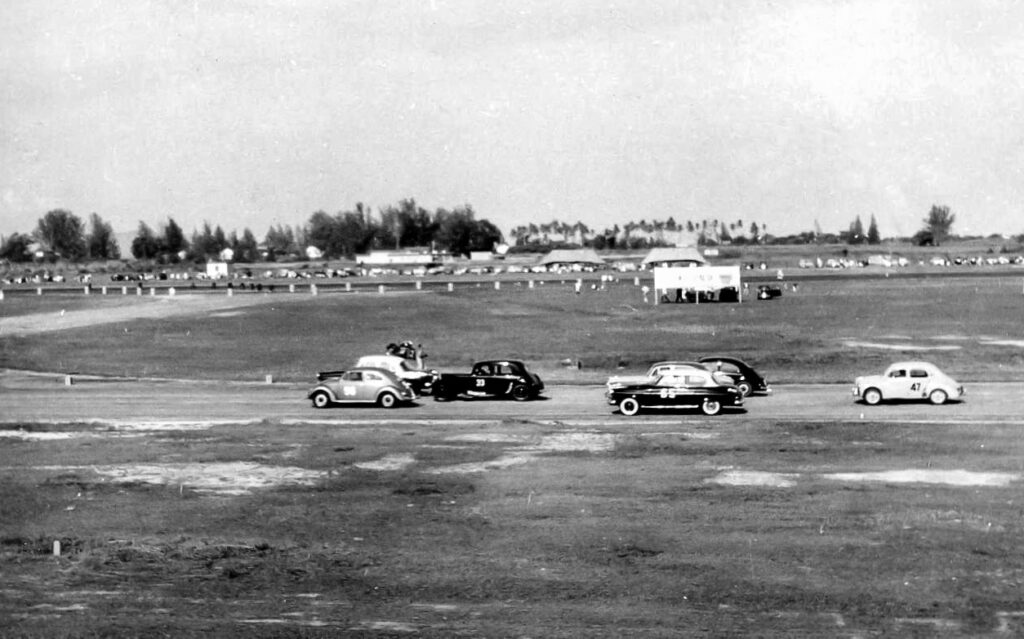
The Saloons and Tourer race followed with a mix of Fiat, DKW, Borgwards, VW Beetle, Renault, Peugeot, Simca, MG, Citroën, Riley and Ford Zephyr represented. The results are beyond the scope of this basic article.
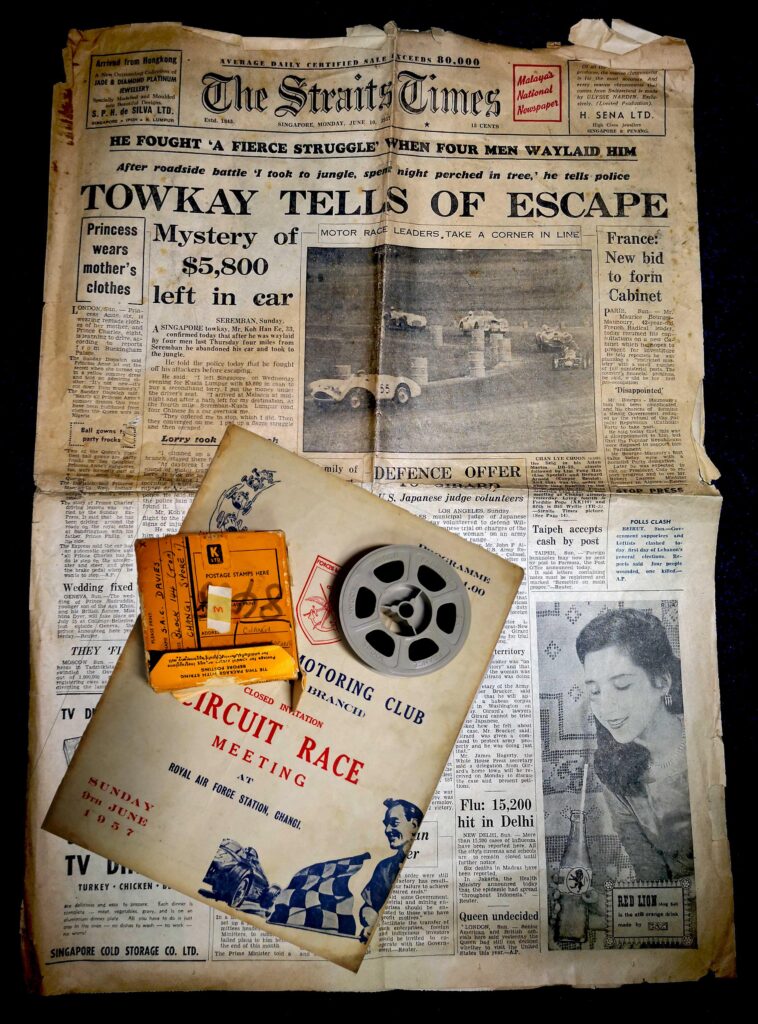
FLY PAST
FLY PAST: The icing on the cake was the landing of a de Havilland DH 106 Comet, the world’s first commercial jet airliner, on the airfield at six that evening. The party after the show would have been a good one as there was nothing left in the kitty from this occasion for the Forces Motoring Club.
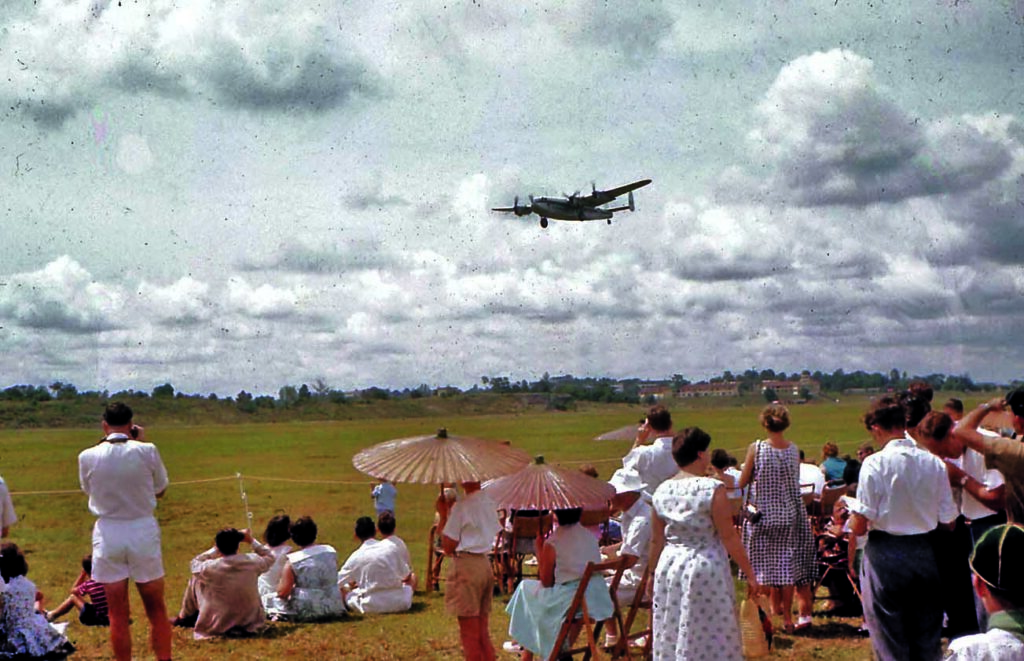
It is not known whether Air Marshal Sir Francis Fressanges [b. 27 February 1902 d. 17 October 1975], Commander-in-Chief, Far East Air Force from 1954 to 1957, attended the event after his short visit to Manila, however after the races, he presented the prizes at a dinner function at the Royal Singapore Golf Club, located at Sime Road (which incidentally was another of the Prisoner of War camps during the Japanese Occupation (1942-1945).
The racing scene on the island and in Malaysia had been rapidly evolving. Johore’s street Grand Prix that ran between 1949 and 1953 had been shelved after a fatal accident in 1953 and by the escalation of the Malayan Emergency. This, however, had not stopped the SMC (see SMC history), and the Malayan Motor Sports Club (see MMSC history), from hosting regular speed trials and hill climbs throughout the peninsula. The Changi Circuit Race may have been a one-off, but it opened the doors to a brighter future for motor sports enthusiasts. In fact, so well received had the weekend been that there was much optimism that this would become a regular feature of the local motor racing season. It didn’t happen but in 1961, Singapore held its first Grand Prix.
POST SCRIPT
POST SCRIPT: The article presented above covering the June 1957 event is based entirely on primary records (multiple copies of the race program), several local press clippings (including newspaper headlines and pre-race supplements), personal photographs (multiple sources), oral interviews with several of the entrants, cine film taken by a member of the RAF stationed in Singapore, and published biographies and interviews with those who attended (Major Mike Tice, Paul Gibbs Pancheri, Rex Carkeek, Stanley Leong & Lim Peng Han).
The author has been unable to find any documentary evidence to corroborate the local narrative that this RAF Changi circuit race was held in 1955 instead (or indeed one before or after the June 1957 event recorded above).
Twenty-five feet of film digitised and partially edited for this article.
By Eli Solomon

